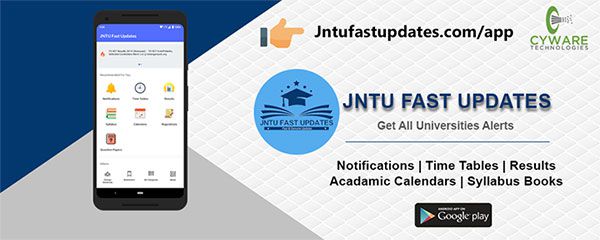JNTUK R16 3-2 Energy Audit, Conservation & Management Material PDF Download
Students those who are studying JNTUK R16 EEE Branch, Can Download Unit wise R16 3-2 Energy Audit, Conservation & Management Material/Notes PDFs below.

JNTUK R16 3-2 Energy Audit, Conservation & Management Material PDF Download
Preamble: This is an open elective course developed to cater the current needs of the industry. This course covers topics such as energy conservation act and energy conservation. It also covers energy efficient lighting design. The student will learn power factor improvement techniques, energy efficiency in HVAC systems. In addition The economic aspects such as payback period calculations, life cycle costing analysis is covered in this course.
OBJECTIVES:
- To understand energy efficiency, scope, conservation and technologies.
- To design energy efficient lighting systems.
- To estimate/calculate power factor of systems and propose suitable compensation techniques.
- To understand energy conservation in HVAC systems.
- To calculate life cycle costing analysis and return on investment on energy efficient technologies.
UNIT-1
Basic Principles of Energy Audit and management Energy audit – Definitions – Concept – Types of audit – Energy index – Cost index – Pie charts –Sankey diagrams – Load profiles – Energy conservation schemes and energy saving potential – Numerical problems – Principles of energy management – Initiating, planning, controlling, promoting, monitoring, reporting – Energy manager – Qualities and functions – Language – Questionnaire – Check list for top management.
Unit–2
Lighting Modification of existing systems – Replacement of existing systems – Priorities: Definition of terms and units – Luminous efficiency – Polar curve – Calculation of illumination level – Illumination of inclined surface to beam – Luminance or brightness – Types of lamps – Types of lighting – Electric lighting fittings (luminaries) – Flood lighting – White light LED and conducting Polymers – Energy conservation measures.
Unit–3
Power Factor and energy instruments Power factor – Methods of improvement – Location of capacitors – Power factor with non linear loads – Effect of harmonics on Power factor – Numerical problems. Energy Instruments – Watt–hour meter – Data loggers – Thermocouples – Pyrometers – Lux meters – Tong testers – Power analyzer.
Unit–4
Space Heating and Ventilation Ventilation – Air–Conditioning (HVAC) and Water Heating: Introduction – Heating of buildings – Transfer of Heat–Space heating methods – Ventilation and air–conditioning – Insulation–Cooling load – Electric water heating systems – Energy conservation methods.
Unit–5
Economic Aspects and Financial Analysis Understanding energy cost – Economics Analysis – Depreciation Methods – Time value of money – Rate of return – Present worth method – Replacement analysis – Life cycle costing analysis – Energy efficient motors (basic concepts) – Economics of energy efficient motors and systems.
Unit–6
Computation of Economic Aspects Need of investment, appraisal and criteria – Calculation of simple payback period–Return on investment – Net present value – Internal rate of return – numerical examples – Power factor correction – Lighting – Applications of life cycle costing analysis – Return on investment – Numerical examples.
TEXT BOOKS:
- Hand Book of Energy Audit by Sonal Desai- Tata McGraw hill
- Energy efficient electric motors by John .C. Andreas, Marcel Dekker Inc Ltd–2nd edition, 1995
REFERENCE BOOKS:
- Energy management by W.R. Murphy & G. Mckay Butter worth, Elsevier publications. 2012
- Electric Energy Utilization and Conservation by S C Tripathy, Tata McGraw hill publishing company Ltd. New Delhi.
- Energy management by Paul o’ Callaghan, Mc–Graw Hill Book company–1st edition, 1998.
- Energy management hand book by W.C.Turner, John wiley and sons.
- Energy management and conservation –k v Sharma and pvenkataseshaiah-I K International Publishing House pvt.ltd,2011.
OUTCOMES:
- Explain energy efficiency, conservation and various technologies.
- Design energy efficient lighting systems.
- Calculate power factor of systems and propose suitable compensation techniques.
- Explain energy conservation in HVAC systems.
- Calculate life cycle costing analysis and return on investment on energy efficient technologies.


320-x100(1).gif)
